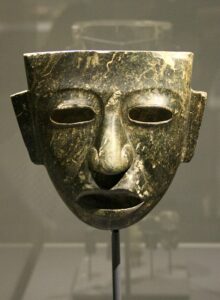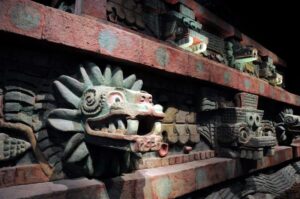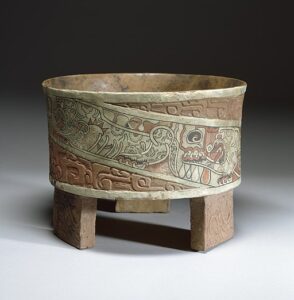Among the hundreds of archaeological sites in Mexico, Teotihuacan is the most visited, even more than the New Wonder of the World, Chichen Itza, or the mysterious city of Monte Albán, in Oaxaca. Teotihuacan is for Mexicans a pre-Hispanic Mecca. Teotihuacan is now a Unesco World Heritage Site.
Visiting Teotihuacan is a pilgrimage many families make, that creates some of the most treasured memories of our childhood, and having climbed the hundreds of steps of the Pyramid of the Moon is an experience that we like to boast about.
To ancient Mexicans, Teotihuacan was a holy city. Located a 40 miles northeast of Mexico City, it was the birthplace of the fifth sun. “The world had been destroyed four times. To bring forth the rise of a new sun the gods gathered at Teotihuacan.
 They performed sacrifices and life returned to earth: the fifth sun was born.
They performed sacrifices and life returned to earth: the fifth sun was born.
Many assume that the Aztecs or Mexicas built Teotihuacan, but it was not. In fact, historians do not yet know who constructed it, but they do confirm that it dates centuries before our era, and that in its period of splendor it was inhabited by 150 to 200 thousand people and that it extended more than 20 square kilometers of built territory.
Teotihuacan became the most important city of ancient Mexico from 300 B.C. to 900 A.D., approximately. During this period, the Teotihuacan Empire exerted its influence upon many regions in Mesoamerica.
Its architecture displayed monumental characteristics.
Given its mystical essence, thousands of people visit Teotihuacan and ascend the Pyramid of the Sun and Moon during the spring equinox every March 21. Do not visit Teotihuacan if your intention is to learn about this archaeological marvel in depth.
The Pyramid of the Sun and the Pyramid of the Moon supported temples dedicated to a particular deity. The city exudes an atmosphere of peace and greatness.
The ceremonial center was planned along a North -South axis, known as Avenue of the Dead, on both sides of which, the palaces where the higher class lived and the temples for their religious ceremonies were built.
A thousand years later, Tenochtitlan, the Aztec capital was built after the Teotihuacan model.
The urban center had a sewer system, which demonstrates their knowledge of city planning.
Each residential complex was made up of many rooms and interior courtyards.

Quetzalcoatl Temple
The Quetzalcoatl Temple shows the extent of their remarkable artistic talent. It is beautifully decorated with conch shells, plumes, and serpents.
They decorated their temples and the palaces of priests and noblemen with frescoes and mural paintings of religious themes.
The Teotihuacan were great merchants and they extended their trading as far as the Gulf of Mexico and Oaxaca.
Obsidian articles and pottery were some of their most important commercial products.
Pottery was handmade, but it was also mass-produced for trading using molds.
Teotihuacan was mysteriously abandoned due in part, to a great fire that might have been caused by a conquest or by barbarians from the north.
When the Aztecs went by this area, they were so impressed with its greatness that they called it Teotihuacan, which means The Place where Men become Gods.
 When the Teotihuacan Empire began its decline, some northern tribes, probably culturally inferior to them, arrived in Mesoamerica.
When the Teotihuacan Empire began its decline, some northern tribes, probably culturally inferior to them, arrived in Mesoamerica.
During your visit to Teotihuacan, you can tour the residential complexes of Tetitla, Atetelco, Tepantitla and La Ventilla, where exquisite mural paintings have been preserved, as well as walking along the Calzada de los Muertos, delimited by several buildings that were once Temples and residences of the Teotihuacan elite.
Other must-sees are the Teotihuacan Museum of Murals and the Teotihuacan Culture Museum. There is also a sculptural garden where archeological pieces are on exhibit and there is a botanical garden with the flora of the region.
Very close to Teotihuacan is the former convent of Acolman, an Augustinian monastery that preserves religious mural paintings and an extraordinary architectural façade. This convent is where some of the most treasured traditions of the Mexican of Christmas began, such as the posadas, piñatas, and pastorelas.
Location: Teotihuacan is located 40 kilometers northeast of Mexico City, on the Ecatepec Pirámides Highway, km. 22 + 600, Municipality of Teotihuacan, State of Mexico.
How to get there: Teotihuacan can be reached from Mexico City by the av. Insurgentes Norte to reach the highway Mexico Pachuca. You can also reach the Ecatepec Pyramids, Mexico Tuxpan and Arco Norte, and Mexico Teotihuacan highway.
Visit time: Set aside a whole day for your visit. The archaeological zone opens at 9 AM and closes at 4:30 PM.
Guided Tours: There are certified tour guides within the archaeological zone. They must be accredited by the National Institute of Anthropology and History (INAH) or the Secretary of Tourism. From Mexico City, you can hire the tour in practically all travel agencies. We recommend the tour organized by INAH during the weekends.
Where to eat: Very close to Teotihuacan is San Juan Teotihuacan, a town where you will find hotels and restaurants for all budgets. One of the most traditional is La Gruta, which opened in 1906.
Shopping: Within the archaeological zone you will find many vendors offering handicrafts. We recommend that you be careful with your purchases. You always can haggle with the sellers. Look for established places. The museums of the site have shops where you can find videos, books, crafts, postcards, magazines, T-shirts, and a variety of souvenirs.
What to bring: To visit Teotihuacan, do not forget a sun block, comfortable shoes, dark glasses and a hat. Although the weather is chilly in the morning, we recommend you wear light clothing. Take bottled water, camera or video; you will need to pay extra at the entrance to take pictures or video.
The Museum De Young in San Francisco will have a spectacular exhibition about Teotihuacan:
Teotihuacan: City of Water, City of Fire September 30, 2017 – February 11, 2018



